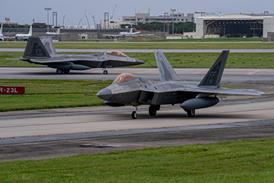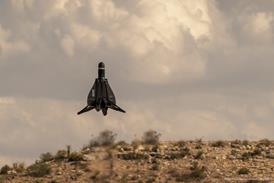Graham Warwick/WASHINGTON DC
The USA has a concept for how the next war will be won, and unless its allies and coalition partners get with the game, they may not be able to join the fight.
With its expeditionary deployments, force experiments and technology demonstrations, the US military is developing ways to apply its superior force rapidly and decisively. But in the race to overwhelm its enemies, the USA risks outrunning its allies.
Since Kosovo, European NATO nations have been working to close the capability gaps exposed by Operation Allied Force, but the alliance's fragmented and bureaucratic development and procurement processes cannot keep pace with those in the USA.
Its buying power may have been diminished, and its research budget decimated, by the post-Cold War drawdown, but the US Department of Defense (DoD) still wields a formidable technological edge - over enemy and ally alike. Lessons learned in Kosovo are leading the USA to look for ways to make the edge sharper and its application quicker.
If the command and control, precision strike and logistic demands of Allied Force stretched NATO's interoperability, then the US concept of "rapid decisive operations" could stress it beyond breaking point. Bringing overwhelming force to bear rapidly and decisively requires technology the USA is only just developing and may be reluctant to share.
Already, obstacles to interoperability have been encountered in joint force experiments, where NATO allies have been denied access to information because of US technology concerns. The USA is reforming its technology transfer mechanisms to help close the capability gap, but not fast enough to keep pace with technology development.
"Change" is the buzzword at the DoD as it forsakes the stability of the Cold War balance of power for the unpredictability of the new world order. But the drive for flexibility does not always sit well with the need for interoperability, which requires stable standards open to all participants. Flexibility also demands technology and innovation - two resources jealously guarded by the USA.
Flexible vs interoperable
The challenge faced by the US military in becoming flexible while remaining interoperable is illustrated by the growing role of the Defense Advanced Research Projects Agency (DARPA) as a "change leader" within the DoD. DARPA was on the front line in Kosovo making changes to the Predator unmanned air vehicle (UAV) to allow its video to be used for targeting. Back home, DARPA is fostering laboratory work on leading edge technologies that promise to be key to future US prosperity.
It is this breadth of activity that makes DARPA unique among US research organisations. Its current programmes range from experiments in the precision engagement of moving targets to demonstrations of the next generation of electronic devices beyond silicon.
Most of DARPA's research programmes break down into two basic categories: demonstration of technical innovations that will enable US forces to achieve operational dominance in the near term, and development and exploitation of high-risk, high-payoff technologies that promise operational dominance in the future.
One focus of the first track is the development of affordable systems enabling the rapid, precision targeting of moving vehicles - such as mobile tactical ballistic missile or surface-to-air missile (SAM) launchers. The aim of the Affordable Moving Surface Target Engagement (AMSTE) programme is to demonstrate that, without expensive modification to present systems, networked sensors and weapons can locate and destroy moving targets.
AMSTE uses a network of ground moving target indication (GMTI) and synthetic aperture radar (SAR) sensors to track moving vehicles and provide targeting updates to precision guided munitions while they are in flight. The programme will also look at using netted sensors to provide precision targeting for "non-smart" weapons. An experimental system, consisting of radars, datalinks and weapons, will be tested next year.
While AMSTE recognises that advances in smart munitions will force vehicles to move to survive, DARPA's Counter Camouflage, Concealment and Deception programme acknowledges that targets can still hide from today's sensors. The programme is developing a foliage penetration (FOPEN) synthetic aperture radar than can provide all weather, day/night detection of concealed stationary targets. By combining FOPEN radar with electronic support measures (ESM), DARPA hopes to detect and track moving targets obscured by foliage. Flight tests begin this year, with a FOPEN SAR installed in a Raytheon RC-12.
Hard and buried
Although moving targets represent the greatest near-term challenge to military planners, hardened and deeply buried bunkers for nuclear, biological or chemical weapons are regarded as a serious and growing threat. Under the Counter Underground Facilities programme, DARPA is developing technologies to identify bunkers by their seismic, acoustic and electromagnetic signatures, and to locate critical systems, such as power, for attack.
To meet emerging threats, DARPA plans to demonstrate an affordable hypersonic missile able to strike moving, hard or buried targets at long range and short notice. The Affordable Rapid Response Missile Demonstrator programme aims to produce a $200,000 air-launched weapon with a speed of Mach 6-8 and a range of up to 1,000km (600 miles).
The missile would allow launch aircraft to stand off from heavily defended areas yet still strike with speed and precision. A "waverider" air-breathing missile design has been selected and Boeing will begin fabrication of demonstrator hardware next year.
Under the Advanced Tactical Targeting Technology (AT3) programme, DARPA will demonstrate a passive targeting system for lethal suppression of enemy air defences (SEAD). This will use networked next-generation ESM systems on fighters, UAVs and other available aircraft to precisely locate SAM threat emitters within seconds, before they shut down or "shoot and scoot".
Each aircraft will be equipped with a small, lightweight package consisting of a global positioning system (GPS) receiver, precision clock, wideband receiver/processor and threat association algorithms. Emitter detection time and receiver location will be exchanged between host platforms allowing SAM threats to be geolocated rapidly and precisely. Raytheon has been selected to flight test AT3 in 2002.
As it has reduced its force structure, the DoD has almost eliminated the use of dedicated SEAD aircraft. The AT3 programme is one way to fill the resulting gap. Another is to use unmanned combat air vehicles (UCAVs) for the dangerous task of destroying enemy SAM sites. DARPA and the US Air Force have begun a programme to demonstrate the technical feasibility of using a "man-in-the-loop" UCAV system for post-2010 SEAD and strike missions.
Manned and unmanned
Boeing is building two full-scale air vehicle demonstrators and a reconfigurable mission control station. Flight tests will begin next year and will culminate in an autonomous lethal SEAD mission using both demonstrators. The US Navy has begun working with DARPA on a naval UCAV capable of operating from ships and performing surveillance missions in addition to SEAD and strike.
One critical requirement for combined manned and unmanned operations mixing fighters and UCAVs is a robust communications network. With this in mind, DARPA is developing the Airborne Communications Node (ACN). This programme aims to provide assured communications by using existing manned and unmanned aircraft as high-bandwidth relay stations.
The critical technical challenge for the ACN, says DARPA, is the electromagnetic interference cancellation required to package many channels into a small payload with the minimum number of antennas. This is necessary for installation on the Northrop Grumman Global Hawk high-altitude, long-endurance UAV and scalable for use in helicopters and tactical UAVs. Lockheed Martin and Raytheon were awarded contracts earlier this year to competitively develop ACN hardware. One contractor will be selected in 2002 to begin flight trials.
While ACN is intended to provide a robust communications network over the battlefield, DARPA's GPS Experiments programme aims to provide friendly forces with assured access to precision navigation. The concept involves the rapid deployment of high-altitude UAV-based airborne pseudolites into a theatre of operation to combat the effects of GPS jamming. The higher power of the pseudolite transmissions, compared with the basic GPS satellite signals, would help overcome jamming.
Moving into space
DARPA and the USAF plan to determine the technical feasibility and affordability of a space-based surveillance system through the Discoverer II programme. This will demonstrate technology for satellites providing high-resolution GMTI and SAR imaging.
Lockheed Martin and TRW were selected earlier this year to begin designing the satellites, with one contractor to be selected next year to launch two demonstrator spacecraft in 2005. The Discoverer II programme has been attacked by Congress, however, because of its cost. DARPA estimates the demonstration programme will cost over $700 million, not including the satellite launches.
This dwarves the amount DARPA spends on high-risk, high-payoff technologies, the long-term benefits of which could be measured in billions of dollars. Examples include the Next Generation Internet (NGI) programme, under which DARPA is funding work on technologies to dramatically increase the speed and capacity of the net. Already the NGI SuperNet testbed is 100 times faster than today's internet. Military applications include virtual radar consoles, but the commercial potential is obvious. DARPA is funding work on technologies to print electronic circuits on to aircraft skins; to create paper-thin disposable electronic displays; to produce much faster processors by using microscopic lasers to link microchips optically; to use high-temperature superconducting filters to increase the sensitivity of communications intelligence receivers and to enable self-forming networks so that a soldier can work with a swarm of micro-robots.
MEMS the word
DARPA is pumping money into the new field of microelectromechanical systems (MEMS). These integrate sensing, processing, actuation, communications and even power on to micro-chips. MEMS applications range from flow control inside jet engines to tiny "pico-satellites" that inspect other spacecraft.
Under its new Beyond Silicon programme, meanwhile, the agency is beginning the search for the next quantum leap in electronics technology. Computers assembled from molecules, even devices that mimic biological systems, all lie in the future.
Through DARPA, a bewildering array of technology is being brought to bear on the US military's desire to apply force more rapidly and decisively. Unless its NATO allies can match, or somehow gain access to, these developments, the US risks widening, rather than closing, the capabilities gap. DARPA's vision is to be the "technical enabler for innovation" within the DoD. If the agency succeeds in enabling the US military to adapt quickly and flexibly to a changing world, the implications for coalition interoperability are enormous.
Source: Flight International























